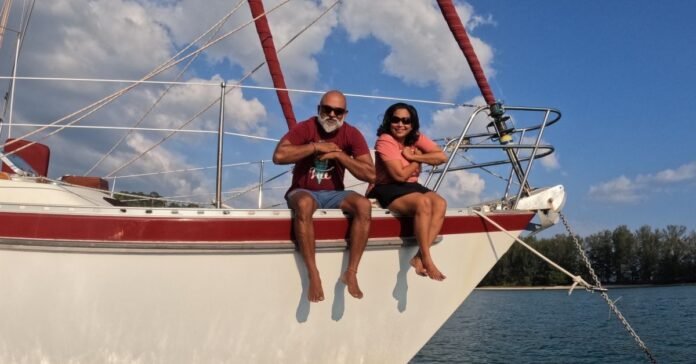
For most people, home is a house with four walls, but for Capt Gaurav Gautam, a retired Indian Navy officer, and his family, home is a 42-foot-long sailboat named ‘Reeva.’ Since 2022, Gautam, his wife Vaidehi Chitnavis, a media professional, and their daughter Kaeya have embraced an unconventional lifestyle, sailing across the world on their solar-powered vessel.
A Nomadic Life on the Waters
For 14-year-old Kaeya, vacations are the best part of this extraordinary journey. Unlike her peers who return home to a stationary abode, her home floats on the ocean. Reeva, their 1988-built Tayana Vancouver 42 sailboat, has become an integral part of their lives, offering adventure, tranquility, and an endless connection with nature. Snorkeling, sailing, and watching the sunset from the deck are just everyday experiences for Kaeya.
When she shared her story with a group of curious students, the most frequent question was, “Is it even possible to live on a boat?”
From an Idea to Reality
Gaurav was once equally skeptical. His fascination with life at sea began in 2015 when he commanded INS Tarangini, the Indian Navy’s first sail training ship. Although intrigued, the practicalities of boat life seemed daunting—finding a suitable vessel, importing it, securing a docking space, and managing maintenance.
However, the COVID-19 pandemic rekindled his dream when he noticed a significant dip in boat prices globally. After careful deliberation, he and Vaidehi made the bold decision to sell everything they owned and take to the seas. The transition wasn’t easy—downsizing from 6,000 kg of possessions to just 120 kg was a daunting task. Giving away heirlooms, including Vaidehi’s cherished Czechoslovakian crockery set, was particularly emotional. But soon, Reeva became their new home, complete with two cabins, a galley (kitchen), a shower, and even a salon.




Adjusting to the Ocean’s Rhythms
Life at sea demands a complete shift in perspective. Simple luxuries, such as ordering food online, become impossible. The family has adapted by cooking simple meals, avoiding elaborate Indian dishes that require excessive heat and fuel. Meals now consist of one-pot dishes, like a makeshift biryani with rice, vegetables, and chicken. Grocery shopping is done at ports along their route, with an emphasis on preserved foods and frozen meats.
Water conservation is crucial. Long showers are a luxury they cannot afford. Instead, they bathe using seawater followed by a quick freshwater rinse. This minimalist lifestyle extends to their wardrobe, with Gaurav trading his collection of formal shoes for just a few pairs of sandals and flip-flops.
A Self-Sustaining Floating Home
Reeva is powered by an 800-AH battery bank charged through 760-watt solar panels and a wind generator. When necessary, an alternator on the boat’s main engine provides backup power. Rainwater harvesting also plays a crucial role in their self-sufficient lifestyle, with collected rainwater supplementing their drinking supply.
Weathering the Storms
Life on a boat isn’t all about serene sunsets and endless horizons. Watchkeeping, navigation, and ever-changing weather conditions require constant vigilance. Despite the challenges, the family thrives on the adventure. While they’ve never been truly stranded, international maritime laws ensure that any vessel in distress is granted temporary refuge.
Navigating through high-traffic waters, such as the Malacca Strait, can be nerve-wracking, especially at night. But Vaidehi believes every challenge is a lesson. “Limited space, limited water, sleeping on a rocking boat—these are things you learn to adapt to,” she says.
The Journey Ahead
Over the past two years, the family has sailed through Southeast Asia, experiencing breathtaking destinations while continuously learning how to maintain and repair their home at sea. Their journey has been one of self-discovery, adventure, and sustainable living.
For Capt Gaurav Gautam, life at sea is limitless, bound only by imagination. His philosophy is simple yet profound: “Go at the pace the wind takes you—at sea, and in life.”

